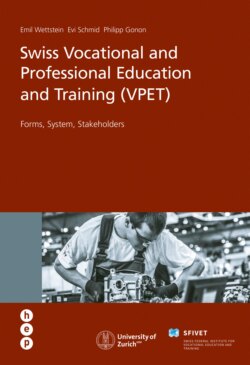Читать книгу Swiss Vocational and Professional Education and Training (VPET) - Philipp Gonon, Emil Wettstein - Страница 33
На сайте Литреса книга снята с продажи.
1.9.1 Definition, variants
ОглавлениеForms of VET courses characterised by social pedagogy often combine career preparation measures with VET at the workplace in an institution, followed by – socio-pedagogically supported – training in companies:
•Homes for young people: assisted living in conjunction with an internal training programme (professional integration programme, vocational training) or an external day centre (vocational training, school); one example is the Gfellergut centre in Zurich.
•Establishments for juvenile male delinquents and young adults in closed and open departments, where measures for young adults are implemented according to Art. 61 of the Schweizerisches Strafgesetzbuch or StGB (Swiss Criminal Code), protective measures according to Art. 15 and 16 of the Bundesgesetz über das Jugendstrafrecht or JStG (Juvenile Criminal Code) and/or custodial sentences for youths according to Art. 25 JStG. Examples are the facilities for the execution of measures at the Massnahmenzentrum Uitikon, Zurich, and the Arxhof in Niederdorf, Basel Landschaft.
•Cooperative training associations with a socio-pedagogical focus which are active on behalf of people who “have to approach permanent (re-)entry into professional life or VET with difficult conditions” (Overall Basel, 2013). One example is the association axisBildung, Bülach (cf. Chapter 1.9.2, p. 58)
•Education and training institutions whose activities are focused on preparing people for working life, i.e. facilitating the transition from compulsory education to basic training, for example Impulsis Zurich and “Einstieg in die Berufswelt” (Entry into the World of Work) in Baar.
•Training facilities “for young people in particular circumstances” who are looking for “particular” pathways in order to enable their learners to enter the regular labour market and, therefore, have a self-determined life. The best-known training facility of this kind is the Stiftung Märtplatz (“market place” foundation) in Rorbas-Freienstein, Zurich. In its own workshops or at regional companies, Märtplatz looks for a training programme which meets the needs of the respective person as closely as possible and even prepares for qualifications of other European countries if no suitable qualification is regulated in Switzerland for the respective learner.
Measures characterised by social pedagogy are not self-supporting. Although productive work is carried out in most of these institutions, like at trade schools and other school-based VET programmes, this is primarily a means to an end and not the purpose of the institution. The deficits are largely borne by the authorities which place the learners: social security institutions (disability insurance, supplementary benefits), youth custody, labour market authorities (Arbeitslosenversicherungsgesetz or AVIG – Unemployment Insurance Act), welfare authorities, promotion of integration.
